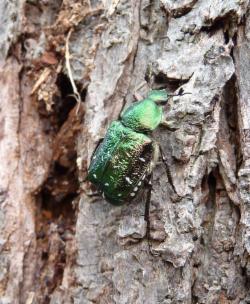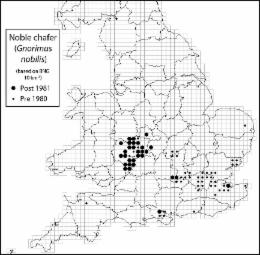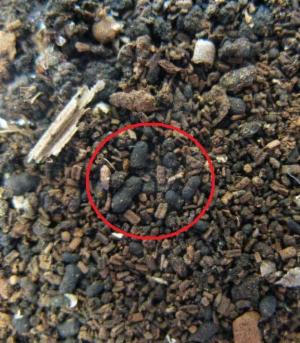 Within Britain this beetle is a specialist of old orchards as its larvae feed on the decaying timber of fruit trees. Evidence of the beetle has been found in plum, damson, apple, cherry and, rarely, perry pear. The larvae grow to around 3cm long and will spend up to 2 years feeding inside the tree before pupating. During the flight period (between late May to end July depending on weather conditions) the adults will emerge from the trees on warm days to nectar on flowers such as hogweed, meadowsweet and elder. However, sightings of the adults are rare and if they find a mate within the tree they may never leave at all! The adult beetles are about 2cm long with striking metallic green-bronze bodies.
Within Britain this beetle is a specialist of old orchards as its larvae feed on the decaying timber of fruit trees. Evidence of the beetle has been found in plum, damson, apple, cherry and, rarely, perry pear. The larvae grow to around 3cm long and will spend up to 2 years feeding inside the tree before pupating. During the flight period (between late May to end July depending on weather conditions) the adults will emerge from the trees on warm days to nectar on flowers such as hogweed, meadowsweet and elder. However, sightings of the adults are rare and if they find a mate within the tree they may never leave at all! The adult beetles are about 2cm long with striking metallic green-bronze bodies.
 The noble chafer is classed as Vulnerable within the UK and it is a national as well as local Biodiversity Action Plan species. This status reflects the agricultural intensification, declining economic viability and neglect that has reduced the extent of the traditional orchard habitat the beetle requires.
The noble chafer is classed as Vulnerable within the UK and it is a national as well as local Biodiversity Action Plan species. This status reflects the agricultural intensification, declining economic viability and neglect that has reduced the extent of the traditional orchard habitat the beetle requires.
The beetle’s distribution in England is centred mainly on Worcestershire, Herefordshire and Gloucestershire, with outlying populations in the New Forest, south Oxfordshire and Kent. Any old orchard in Worcestershire with suitable decaying wood habitat has the potential to contain and support a population of noble chafer.
Distribution map produced by People’s Trust for Endangered Species, the national lead body for the noble chafer Biodiversity Action Plan.
 The easiest way to search for noble chafer is to look for the droppings, known as frass, excreted by the larvae. They look like instant coffee granules, 3-5mm long, and are quite easy to spot and identify once you have your eye in. First, take a good look around the trunk and larger branches of the tree for any holes or cavities you can safely reach (don’t forget to search around the very base of the tree – frass sometime trickles to the bottom if the trunk is hollow).
The easiest way to search for noble chafer is to look for the droppings, known as frass, excreted by the larvae. They look like instant coffee granules, 3-5mm long, and are quite easy to spot and identify once you have your eye in. First, take a good look around the trunk and larger branches of the tree for any holes or cavities you can safely reach (don’t forget to search around the very base of the tree – frass sometime trickles to the bottom if the trunk is hollow).
Carefully insert a long-handled teaspoon into the hole and extract some of the wood mould and debris. Put this in the palm of your hand and smooth it down with the teaspoon. Can you see anything that looks like instant coffee granules? If you think you’ve found some, please put a sample in a small pot or sealable plastic bag and post it to the Worcestershire Biological Records Centre, who will verify whether or not it is noble chafer frass. Don’t forget to include your contact details and the location of the orchard where it was collected.
Please remember…
Worcestershire Biological Records Centre
Lower Smite Farm
Smite Hill
Hindlip
Worcs
WR3 8SZ
records@wbrc.org.uk or 01905 759759